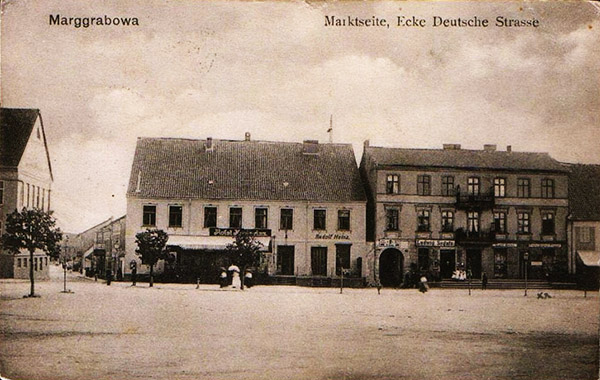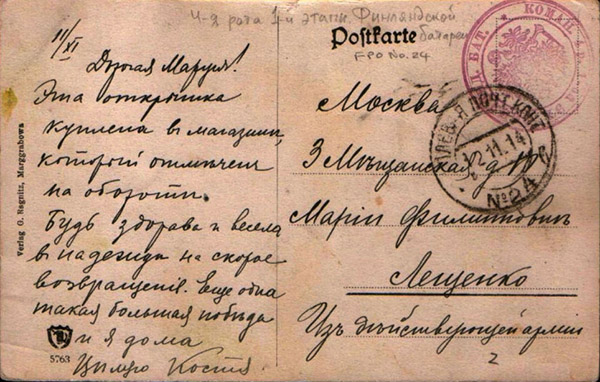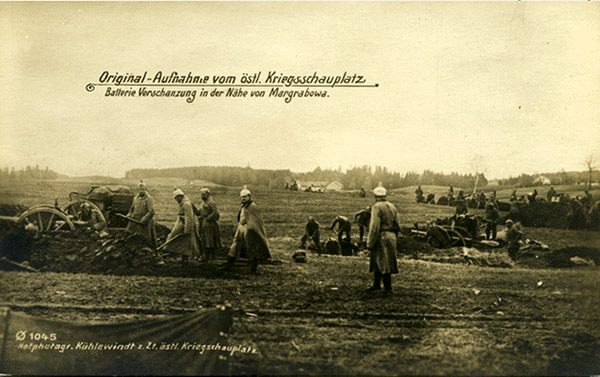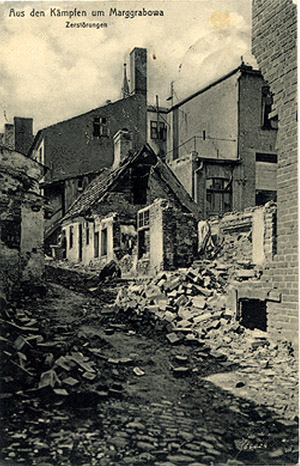Marggrabowa ( after
1928 Treuburg ,
now Olecko )
is a town in the eastern
part of the Masurian Lake District, founded in the 16th century
by order of Duke Albrecht of Hohenzollern .
Moscow
3 Meshchanskaya, 10
Maria Filippovna Leshchenko
«11/XI
Dear Marusya!
This card was bought at the store marked on the back. Be healthy and happy in hopes of a quick return. Another such big victory and I'm home.
Kiss
Kostya"


This is how the “great victory” at Marggrabowa is described in memoirs about the First World War:
"The battle near Margrabov was no less successful for us. Having rested a bit in Lyka, our troops decided to "finish off the Germans". The march was scheduled for the morning. As soon as the troops moved, they immediately began to be shelled with artillery fire. Despite this, we continued to move forward. Not reaching Margrabov by two miles, our troops went on the assault.
The Germans, throwing down their weapons, fled from the trenches. Here we captured about 500 people…
An infantry lieutenant colonel who took part in this case tells about it this way:
"The Germans attached great importance to the positions near Margrabow. They built permanent fortification trenches there, with canopies and loopholes. We began to advance at 11 o'clock in the morning under terrible enemy artillery fire. Our task was to take the enemy redoubt that towered over the trenches. Our artillery worked brilliantly, and the enemy fire began to weaken noticeably. By four o'clock we were already able to rush into the assault. Grenades exploded over our heads, suitcase shells burst, hundreds of guns roared...
The soldiers crossed themselves, and one look at their faces was enough to make it clear that there would be no retreat.
An hour later, the Russian flag was already flying on the redoubt, and unimaginable panic began among the Germans. By taking the enemy redoubt, we secured dominance over the entire area. By evening, we had driven the Germans out of all their trenches, and the famous "impregnable position" near Margrabow, as the Germans called it, was taken by us. Many guns, cars, machine guns, etc. fell into our hands. Our cavalry completed the task of pursuing the enemy…"
(The Second Patriotic War in the stories of its heroes. - Pg., Publishing House of the Skobelev Committee, year of publication not indicated)

"Knowing about the movements of our cavalrymen through the burning fires, the infantry column in which I was myself advanced slowly, meeting only the feeble resistance of small German infantry patrols and moving in the direction of the lake isthmuses along which the macadam roads leading to Marggrabowa were laid. I had to speed up the infantry advance, since I was afraid that the weak cavalry columns, each of which had only five hundred active sabres, would not be able to continue the battle for long enough with the German infantry sent out of Marggrabowa. In addition, there was a danger that after the battle these infantry units would return to Marggrabowa and take up positions on the isthmuses or strengthen the screens that had already been set up there, thereby preventing or at least complicating my entry into the town. My main objective was to capture the telegraph and post office in Marggrabowa with all the correspondence, from which we hoped to glean very valuable information about the enemy. <…>
When our infantry approached the isthmuses, they were found to be held by small detachments of infantry and cyclists (as we later learned). Their numbers could not be ascertained, since most of the cyclists had retreated west and southwest of the town, abandoning about sixty bicycles on the road. They were immediately seized by our riflemen, and some even by the cavalry. While the battle for the isthmuses was continuing, I ordered the cavalry column closest to us to join me. This detachment included the lancers and dragoon regiments, so that when the riflemen had captured the isthmuses and dug in, securing the escape routes, two cavalry regiments with a horse-artillery battery moved forward. They were to capture Marggrabowa and occupy the railway station, the post office, and the telephone and telegraph stations in order to completely destroy these objects. <…>
After a half-hour battle, a rapid attack by the riflemen drove the Germans from the isthmuses, which allowed us to enter the outskirts of the town. By this time, our lancers were approaching. When they arrived, the riflemen were already on the isthmuses. I hurried the squadrons and ordered them to occupy the near approaches to Marggrabowa in loose formation. <…> By this time, all of Marggrabowa, located on the slope facing Lake Olechko, was before my eyes. <…>
Even without field glasses it was clear that white flags with red crosses were flying over all the large buildings. We found out later that some of these houses had actually been converted into hospitals; others, as their occupants informed us, were intended for the same purpose; all the school buildings were also used. Since this was the first time that one of my regiments had gone into battle in my presence, I thought it right, after giving all the necessary orders, to join the first squadron of Uhlans. So, marching beside Staff Captain Makedonsky in the advance line of dismounted Uhlans, I moved in the direction of the near approaches to Marggrabowa, from where we could hear disorderly rifle fire coming from the gardens and windows of houses marked with the emblem of the Red Cross. From somewhere on the flank came bursts of machine-gun fire; two of our machine-guns opened fire in return. The German machine gun, apparently mounted in the window of a tall building, fell silent. The line of our lancers, occasionally firing, stubbornly moved toward the gardens that encircled the cozy town. <…> Meanwhile, our lancers, reinforced by dismounted dragoon squadrons, gradually infiltrated the outskirts of the town; the German fire weakened as they advanced. By this time, it had become obvious that the Germans had no intention of stubbornly defending the town, but would prefer to abandon it instead.
By the time the dismounted cavalry units entered the town, the shooting had died down completely. The town had a completely peaceful appearance. Almost all the shops were closed, but the windows were not covered with shutters, and, apparently, trading had only just ceased here. Many people were looking out of the windows with interest at what was happening; they were mostly women. They readily answered questions about the location of the telegraph, post office and telephone exchange. We found all these buildings on the only town square. <…>
(Vasily Gurko. War and Revolution in Russia. Memoirs of the Commander of the Western Front. 1914-1917. - M., Centerpoligraf, 2007)


